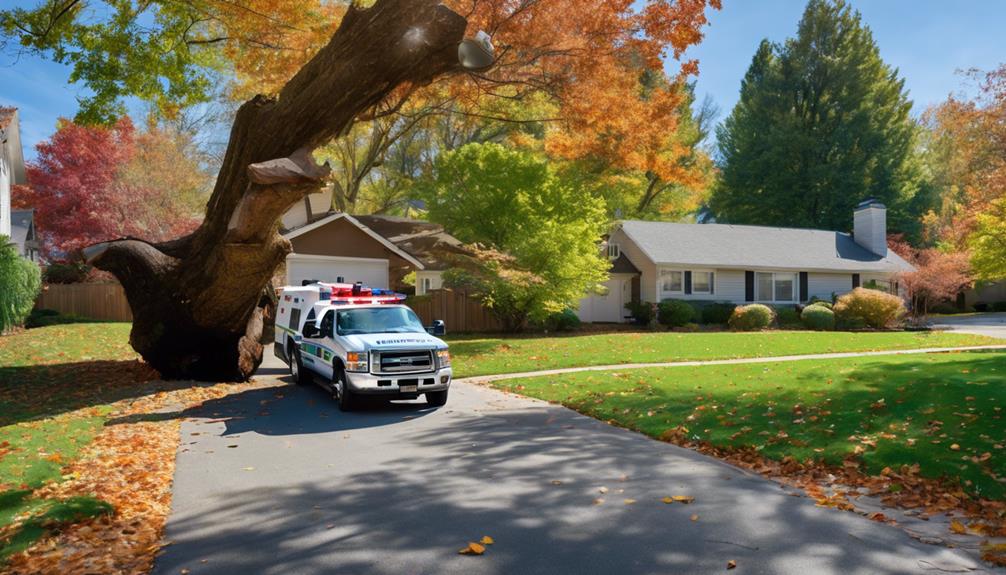
Top Arborist Services for Tree Health and Safety
1 February 2025Why Use Proper Techniques for Uneven Lawn Turf?
2 February 2025When seeking the best emergency tree removal services near you, prioritise those with a strong reputation and quick response times.
Look for companies that offer 24/7 availability and are knowledgeable about local hazards.
It's essential to select services that conduct thorough risk assessments before commencing any work.
Moreover, consider their safety protocols and use of appropriate equipment.
Gathering multiple quotes can also assist in understanding cost variability.
These factors ensure a safe and efficient resolution to your tree emergencies.
For further insights and recommendations on top providers, you may want to investigate additional information.
Emergency Tree Removal Essentials
In emergency situations, a swift response is essential to mitigate potential damage and ensure public safety.
Implementing safety precautions during tree removal is fundamental to protect both the workers and the surrounding environment.
Understanding these fundamentals can greatly enhance the effectiveness of emergency tree removal services.
Importance of Quick Response
Prompt action is crucial when it comes to emergency tree removal, as delays can lead to heightened risks and complications. When a tree poses an imminent threat to property or human safety, timely intervention is paramount.
An unaddressed fallen or leaning tree can cause extensive damage, resulting in costly repairs and potential injury. Furthermore, adverse weather conditions can exacerbate the situation, transforming a manageable scenario into a crisis.
A quick response not only mitigates these risks but also facilitates a more efficient recovery process. Engaging professional tree removal services ensures that the situation is handled with expertise, minimising supplementary hazards.
Ultimately, prioritising swift action in emergency tree removal is critical for safeguarding lives and preserving the integrity of property.
Safety Precautions to Consider
Emergency tree removal requires meticulous attention to safety precautions to protect both workers and bystanders.
Initially, a thorough assessment of the site is fundamental, identifying hazards such as power lines, unstable ground, and nearby structures.
Workers must don appropriate personal protective equipment (PPE), including helmets, gloves, and eye protection.
Establishing a safety perimeter around the work area prevents unauthorised access and minimises risk to bystanders.
Utilising proper cutting techniques and equipment guarantees controlled tree felling, while maintaining communication among team members is vital for coordinating efforts.
Safety and Equipment Standards
Ensuring safety during emergency tree removal necessitates a comprehensive assessment of tree stability, incorporating various evaluation techniques.
Additionally, it is crucial to understand the influence of weather conditions on tree stability for effective decision-making.
Ultimately, evaluating root health is essential to mitigate further risks and maintain the integrity of the surrounding area.
Tree Stability Assessment Techniques
A thorough tree stability evaluation is fundamental for identifying potential hazards and ensuring the safety of surrounding properties and individuals. Professionals employ a range of techniques to assess tree health and structural integrity, which can prevent catastrophic failures.
- Visual Inspection: Evaluating physical signs of decay, cracks, and lean.
- Soil Analysis: Analysing soil composition and drainage to determine root stability.
- Load Testing: Measuring how well a tree withstands different forces, simulating environmental stressors.
- Resistance Drilling: Using specialised equipment to detect internal decay and structural weaknesses.
Implementing these techniques in accordance with safety and equipment standards guarantees a thorough evaluation.
Mastery in these assessment methods is vital for professionals aiming to mitigate risks associated with unstable trees.
Weather Impact on Tree Stability
Weather conditions significantly affect tree stability, presenting various risks that require careful evaluation and management.
Understanding these impacts is essential for ensuring safety and implementing appropriate equipment standards during tree removal operations.
- Wind Shear: Strong winds can uproot or snap branches, leading to hazardous situations.
- Heavy Rain: Saturated soil increases the risk of tree instability and potential collapse.
- Snow and Ice Accumulation: Excess weight can cause limbs to break or trees to topple.
- Extreme Temperatures: Fluctuating temperatures can result in stress cracks and weaken tree structure.
Professionals must assess these conditions meticulously, using appropriate safety gear and equipment to mitigate risks and ensure successful emergency tree removal.
Mastery of these elements is fundamental for effective tree management.
Root Health Evaluation Techniques
Evaluating root health is critical for determining a tree's overall stability and longevity, particularly in emergency situations.
To ensure reliable evaluations, professionals employ a range of techniques that adhere to stringent safety and equipment standards.
- Visual Inspection: Examining the surface roots for signs of decay or damage.
- Soil Testing: Analysing soil composition and moisture levels to gauge root viability.
- Resistograph Testing: Using specialised equipment to measure wood density and detect internal decay.
- Root Excavation: Carefully uncovering roots to assess health without compromising tree stability.
These methodologies, backed by industry standards, facilitate informed decision-making, ensuring that emergency tree removal services can act swiftly and effectively while prioritising safety and environmental considerations.
Emergency Response Protocols
Effective emergency response protocols are vital for ensuring safety during tree removal operations. This includes conducting an initial site assessment to identify hazards, followed by implementing emergency site preparation tips to safeguard both workers and bystanders.
Furthermore, understanding tree climbing rescue methods is fundamental for responding quickly and efficiently in crisis situations.
Initial Site Assessment
Upon arrival at the site of an emergency tree removal, responders must quickly assess the situation to determine the extent of damage and potential hazards.
This initial site assessment is critical for ensuring the safety of both the responders and surrounding individuals.
Key factors to evaluate include:
- Stability of the tree: Evaluate whether the tree is leaning or at risk of further collapse.
- Proximity to structures: Identify any buildings, vehicles, or power lines that may be affected.
- Environmental conditions: Assess weather factors that could complicate removal efforts.
- Access routes: Determine safe entry and exit points for workers and equipment.
Emergency Site Preparation Tips
Proper site preparation is essential for ensuring the safety and efficiency of emergency tree removal operations. By implementing a structured approach, responders can mitigate hazards and streamline the removal process.
Key preparation strategies include:
- Establish a Secure Perimeter: Identify and cordon off the work area to protect bystanders and prevent unauthorised access.
- Evaluate Surrounding Hazards: Assess nearby structures, power lines, and other obstacles that may affect removal operations.
- Prepare Necessary Equipment: Verify that all tools and machinery are readily available and in peak condition to avoid delays.
- Communicate Clearly with Teams: Establish a clear communication plan to improve coordination among team members during operations.
Tree Climbing Rescue Methods
In emergency tree removal scenarios, situations may arise where individuals become trapped in trees, necessitating immediate rescue efforts.
Effective tree climbing rescue methods are crucial for safely extricating individuals while minimising risk to both the victim and the rescuers.
Key techniques include:
- Utilising proper climbing gear to guarantee safety and stability.
- Establishing communication with the trapped individual to assess their condition and needs.
- Employing a two-person rescue team to improve safety and efficiency during the operation.
- Implementing a controlled descent technique to safely lower the individual from the tree.
Mastering these protocols allows emergency responders to act swiftly and effectively, ensuring a successful rescue while maintaining a focus on safety and professionalism.
Cost-Effective Tree Hazard Prevention
While trees are vital to the environment, they can pose significant hazards if not properly maintained. Implementing cost-effective tree hazard prevention strategies is critical for safeguarding property and ensuring community safety. Regular inspections, strategic pruning, and appropriate species selection can mitigate risks without incurring substantial expenses.
Below is a summary of effective prevention measures:
| Prevention Method | Benefits | Cost Estimate |
|---|---|---|
| Routine Inspections | Early detection of potential hazards | £50 – £150/year |
| Strategic Pruning | Reduces weight and risk of falling limbs | £100 – £300/session |
| Species Selection | Choosing disease-resistant varieties | Varies by species |
Plant Health Monitoring Techniques
Effective plant health monitoring techniques are crucial for maintaining the vigour of trees and preventing future hazards.
This includes conducting soil nutrient analysis to guarantee ideal growth conditions, strategically timing fertiliser applications to optimise nutrient uptake, and implementing pest control measures at the most effective moments.
Soil Nutrient Analysis Techniques
Understanding soil nutrient levels is vital for maintaining ideal plant health, as it directly influences growth, yield, and overall vitality. Accurate soil nutrient analysis techniques enable practitioners to assess and enhance soil fertility effectively.
Key techniques include:
- Soil Sampling: Collecting representative samples to ensure comprehensive nutrient evaluation.
- Laboratory Analysis: Utilising chemical assays to quantify macro and micronutrients present in the soil.
- pH Testing: Determining acidity or alkalinity, which affects nutrient availability and plant health.
- Soil Electrical Conductivity (EC): Measuring salinity levels that can impact nutrient uptake.
Employing these techniques allows for informed decision-making, fostering an environment where plants can flourish.
Mastery of soil nutrient analysis is essential for anyone seeking to optimise plant health and yield.
Fertilizer Application Timing Strategies
Ideal fertiliser application timing is crucial for maximising plant health and productivity. Understanding the best moments for application can greatly improve nutrient uptake and overall plant vitality.
Here are key strategies for effective timing:
- Seasonal Considerations: Align applications with growth cycles, typically in early spring and late autumn.
- Soil Temperature: Monitor soil temperature to determine when roots are active, preferably above 10°C (50°F).
- Moisture Levels: Ensure adequate soil moisture before application to promote nutrient absorption.
- Growth Stages: Apply fertilisers during critical growth phases, such as flowering or fruit development, to meet increased nutrient demands.
Pest Control Timing Strategies
Monitoring plant health is integral to implementing timely pest control strategies that safeguard crops and landscapes.
Effective pest management hinges on precise timing, which can greatly improve the efficacy of control measures. By employing systematic plant health monitoring techniques, one can detect pest populations early and respond proactively.
- Regular scouting: Conduct frequent inspections to identify pest presence and damage.
- Threshold levels: Establish economic thresholds to determine when intervention is necessary.
- Phenological observations: Monitor plant development stages to align pest control with pest life cycles.
- Environmental conditions: Assess weather patterns that influence pest behaviour and population dynamics.
Common Obstacles and Remedies
In emergency tree removal, several common obstacles can hinder the process, including root rot and the presence of tree stumps.
Understanding effective treatment options for root rot is vital, as is familiarity with stump grinding techniques that facilitate safer removals.
Furthermore, the training of emergency response teams plays a significant role in ensuring a swift and efficient response to tree-related crises.
Root Rot Treatment Options
Root rot can significantly compromise a tree's health, making timely and effective treatment essential for recovery. Addressing this issue involves understanding the causes and implementing targeted remedies.
- Drainage Improvement: Ensure proper soil drainage to prevent excess moisture, a primary contributor to root rot.
- Fungicide Application: Use suitable fungicides to combat fungal pathogens responsible for root decay.
- Soil Aeration: Aerate the soil to enhance oxygen flow to the roots, promoting healthier growth.
- Tree Removal: In severe cases, removing the affected tree may be the only option to protect surrounding flora and prevent the spread of disease.
Stump Grinding Techniques Explained
After addressing the challenges posed by root rot and potentially removing a compromised tree, stump grinding becomes a crucial next step in restoring the landscape. This process involves reducing the leftover stump to below ground level, facilitating a seamless integration with the surrounding soil.
However, several common obstacles may arise during stump grinding, including:
- Rock presence: Encountering hidden rocks can damage equipment.
- Root entanglement: Extensive root systems can complicate the grinding process.
- Soil density: Hard or compacted soil may hinder grinding efficiency.
- Debris management: Properly handling the resulting wood chips is vital for site cleanliness.
Understanding these challenges and their remedies improves the effectiveness of stump grinding, ensuring a smoother restoration of your outdoor space.
Emergency Response Team Training
Effective training for emergency response teams is vital for ensuring preparedness and efficiency during crises. However, several common obstacles can impede this process, necessitating strategic remedies to improve training effectiveness.
- Resource Limitations: Insufficient funding or equipment can hinder the quality of training.
- Skill Gaps: Varied experience levels among team members can create inconsistencies in response capabilities.
- Communication Barriers: Misunderstandings can occur due to unclear protocols or jargon.
- Time Constraints: Busy schedules may limit opportunities for thorough training sessions.
Addressing these issues through targeted investment, tailored training programmes, clear communication strategies, and flexible scheduling can greatly enhance team performance.
Why Choose TKL Birmingham Gardener
When it comes to selecting a tree removal service, TKL Birmingham Gardener stands out from the competition. Their commitment to excellence is demonstrated through a combination of certified arborists, advanced equipment, and a customer-focused approach.
TKL Birmingham Gardener employs a highly trained team, ensuring that each project complies with the highest safety and industry standards. Their swift response times and comprehensive assessments facilitate the efficient management of emergency situations, minimising potential damage to property.
Furthermore, TKL prioritises environmentally responsible practices, advocating for sustainability in tree removal. Clients benefit from transparent pricing, detailed consultations, and a satisfaction guarantee.
Common Emergency Tree Questions
When faced with an emergency tree situation, clients often have pressing questions that require immediate answers.
Common inquiries include: "What constitutes an emergency tree situation?" Typically, this refers to trees that pose imminent threats to safety or property, such as those damaged by storms or leaning precariously.
Another frequent question is, "How quickly can a removal service respond?" Most reputable services prioritise emergencies, aiming for rapid assessment and action.
Clients also wonder about the costs involved; while prices vary, understanding that safety is paramount can help frame expectations.
Final Thoughts and Recommendations
Emergency tree situations can frequently arise without warning, underscoring the significance of being prepared and informed.
When faced with such incidents, having a reliable emergency tree removal service at your disposal can mitigate risks and ensure safety.
Here are some crucial recommendations:
- Regularly assess the potential hazards around your property.
- Establish a relationship with a certified tree removal service in advance.
- Keep an emergency contact list readily available, including local services and utility companies.
- Educate yourself on the signs of tree distress and potential risk factors.




